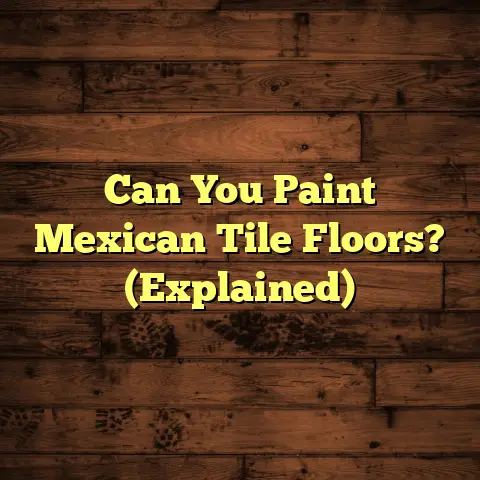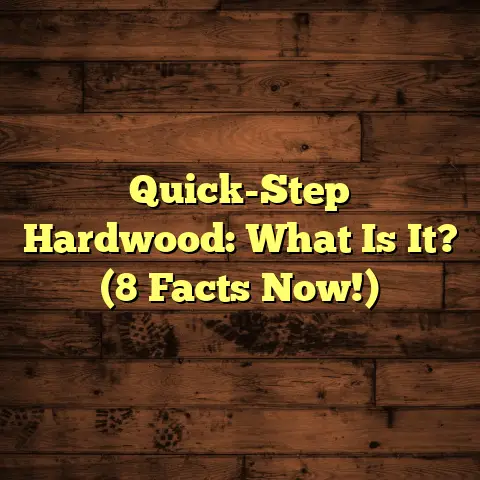Why Chipboard Floors Squeak? (1 Reason Now!)
Today, I want to chat about a flooring option that’s been gaining traction lately: chipboard, also known as particleboard.
It’s a cost-effective and, dare I say, a pretty green alternative to solid wood.
But let’s be real, it’s not without its quirks.
One of the most common complaints I hear is about that dreaded squeak!
So, why do chipboard floors squeak?
Let’s dive in!
The Sustainability of Flooring Choices
In today’s world, we’re all trying to make more responsible choices, right?
That extends to our homes, too.
Sustainable materials are becoming increasingly popular, and for good reason.
They’re better for the environment and often more economical in the long run.
Chipboard fits into this category nicely.
It’s made from recycled wood fibers and adhesives, which means we’re using materials that would otherwise end up in landfills.
Think of it as giving wood scraps a second life!
Choosing chipboard is not only a vote for environmental conservation, but also a smart financial move.
The Focus of the Article: Understanding the Squeak
Okay, so chipboard is eco-friendly and budget-friendly.
That’s great!
But what about that annoying squeak?
I’m here to tell you that you’re not alone.
Many homeowners with chipboard floors experience this issue.
The good news is that understanding the why behind the squeak can help you manage it.
In this article, we’re going to explore the primary reason why chipboard floors squeak.
Trust me, knowing this can save you a lot of headaches (and maybe some earplugs!).
Section 1: The Mechanics of Squeaking Floors
Let’s get down to the nitty-gritty.
Why does that squeak happen in the first place?
Well, the main culprit is movement.
Specifically, movement between the chipboard panels and the subfloor beneath them.
Think of it like this: every time you step on the floor, the chipboard flexes slightly.
If it’s not securely attached to the subfloor, it rubs against it.
And that rubbing?
That’s what creates the squeaking sound.
It’s simple physics, really.
Several factors play a role here.
The installation method, the quality of the chipboard itself, and the condition of the subfloor are all key players.
If any of these are off, you’re more likely to hear that telltale squeak.
Section 2: The Role of Moisture and Temperature
Now, let’s talk about the weather.
Or, more accurately, how weather affects your floors.
Chipboard is particularly sensitive to moisture and temperature fluctuations.
Think of it like a sponge.
When it gets wet, it expands.
When it dries out, it shrinks.
The same thing happens with chipboard, albeit on a smaller scale.
High humidity can cause the chipboard to swell, while dry conditions can cause it to shrink.
And guess what happens when there are gaps?
More movement, more friction, and…you guessed it…more squeaking!
According to the Forest Products Laboratory, wood can expand and contract significantly with changes in moisture content.
This is especially true for engineered wood products like chipboard.
Section 3: The Impact of Age and Wear
Like anything else, chipboard floors age over time.
And as they age, they become more susceptible to problems, including squeaking.
Older chipboard, especially if it hasn’t been properly maintained or has been exposed to excess moisture, can start to warp and deteriorate.
This can lead to uneven surfaces and increased movement, which, as we know, equals squeaking.
Here are a few indicators of wear that I often see in older chipboard floors:
-
Visible cracks: These can weaken the structure of the chipboard and make it more prone to movement.
-
Uneven surfaces: Warping can create high and low spots, leading to uneven pressure and squeaking.
-
Soft spots: These indicate that the chipboard has absorbed moisture and is starting to break down.
If you spot any of these signs, it’s a good idea to address them sooner rather than later.
Ignoring them will only make the problem worse (and the squeaking louder!).
Section 4: The Importance of Proper Installation
I can’t stress this enough: proper installation is key!
I’ve seen so many squeaky floors that were simply installed incorrectly.
It’s heartbreaking, really.
Incorrect installation can lead to a whole host of problems, including:
-
Gaps: If the chipboard panels aren’t properly spaced, gaps can form, allowing for movement and squeaking.
-
Misalignment: If the panels aren’t aligned correctly, they can rub against each other, creating noise.
-
Insufficient fastening: If the panels aren’t securely fastened to the subfloor, they’ll move around and squeak.
Here are a few best practices for installation that I always recommend:
-
Use the right fasteners: Make sure you’re using screws or nails that are specifically designed for chipboard.
-
Space the fasteners properly: Follow the manufacturer’s instructions for spacing the fasteners.
-
Use construction adhesive: Applying a layer of construction adhesive between the chipboard and the subfloor can help to create a more secure bond.
-
Ensure a level subfloor: A level subfloor is crucial for preventing uneven pressure and squeaking.
Section 5: The Influence of Foot Traffic and Usage
Think about how you use your floors.
Do you have kids running around all day?
Do you have heavy furniture?
These factors can all influence how much your chipboard floors squeak.
Higher foot traffic means more wear and tear, which can lead to more pronounced squeaking over time.
Heavy furniture can create pressure points that amplify the sounds.
For example, I worked on a house where the homeowner had a grand piano sitting on a chipboard floor.
Every time someone played the piano, the floor would squeak like crazy!
We ended up reinforcing the subfloor under the piano to distribute the weight more evenly, which helped to reduce the squeaking.
Conclusion: Recap of the Key Points
So, there you have it!
The primary reason why chipboard floors squeak is movement between the chipboard panels and the subfloor.
This movement can be caused by a variety of factors, including:
- Moisture and temperature fluctuations
- Age and wear
- Improper installation
- Foot traffic and usage
While squeaking can be annoying, understanding the mechanics behind it can help you manage your expectations regarding maintenance and longevity.
Don’t let the fear of squeaks deter you from considering chipboard flooring.
It’s a sustainable and economical choice that can be a great option for many homes.
Just be sure to address the potential challenges upfront.
Call to Action: Engage the Reader
So, what do you think?
Are you willing to embrace the potential squeaks in exchange for a more sustainable and budget-friendly flooring option?
Or do you prefer to stick with more traditional materials?
I’d love to hear your thoughts in the comments below!





